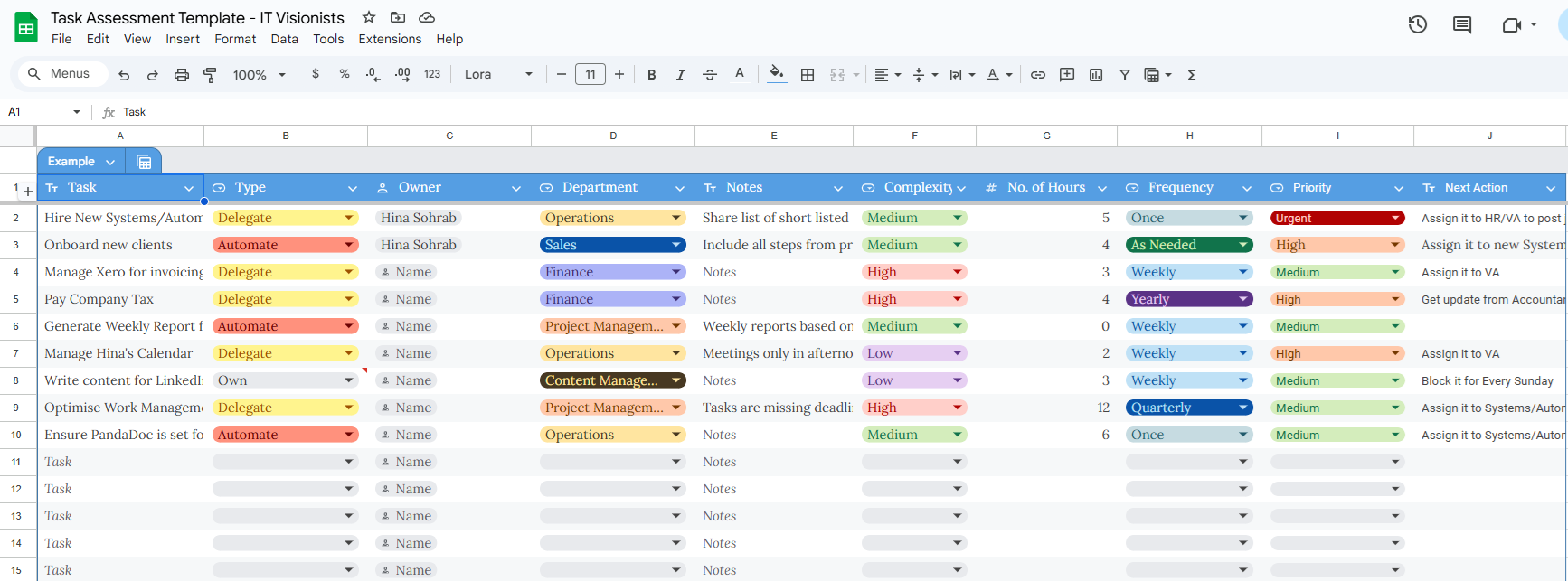
Did you know that entrepreneurs who effectively delegate can increase their business productivity by up to 33%? Yet, many business owners struggle to let go of tasks, trapped in a cycle of overwhelm and inefficiency.
Delegation isn’t just a management technique. It’s a critical strategy for sustainable business growth. While project management tools can help, true delegation requires a strategic approach that transforms how we work.
Handing off responsibilities might feel intimidating, but the rewards are significant.
The good news? Delegation doesn’t have to be complicated. With the right approach, along with a structured Task Assessment Template, you can effectively start delegating tasks and focus on the core elements of our business.
Why Delegation Feels So Hard?
Delegation often triggers fear. We think, “No one can do this as well as I can” or “It’s faster to do it myself.” These thoughts keep us stuck, handling every minute detail and preventing our business from scaling.
The truth is simple: trying to do everything ourselves is the biggest barrier to growth. Delegation isn’t about losing control. It’s about strategically distributing work to focus on what truly matters.
The Secret to Successful Delegation: A Task Assessment Template
Our secret weapon for successful delegation is a comprehensive Task Assessment Template. This tool helps us systematically identify which tasks to:
- Delegate
- Eliminate
- Automate
- Retain
Why This Template Will Make Life Easier
- Focus on What Matters: By using the template, we can identify which tasks genuinely need our attention and which do not.
- Empower the Team: Delegating tasks provides our team with opportunities to grow and take ownership of projects.
- Avoid Burnout: Delegation allows us to free ourselves from the burden of trying to manage everything.
- Prepare for Growth: Setting up a system for delegation now will build a strong foundation for scaling our business later.
How to Use the Task Assessment Template
The first step is evaluating all the tasks we currently manage. As we go through each one, we need to decide if the task should be:
- Delegated: Can someone else handle this more efficiently?
- Eliminated: Is this task even necessary, or is it outdated?
- Automated: Is there technology or software that can take over this process?
- Do by Self: Does this task require my unique expertise or oversight?

Simple Steps to Start Delegating
1. Document Processes
Start by documenting the processes involved in recurring tasks. Include step-by-step instructions, necessary tools, and any tips that might help someone complete the task efficiently. For example, if managing social media is taking up too much time, create a simple guide outlining the types of content to post, hashtags to use, and the posting schedule.
Documenting processes can feel time-consuming at first, but it makes future delegations far easier and ensures tasks are completed consistently.
2. Track Time
For one week, track the time spent on different tasks. We often don’t realize how much time certain responsibilities consume until we see the data. For instance, managing customer emails might take up two hours a day. With this insight, it’s easier to identify which tasks can be delegated.
Consider using tools like Toggl or RescueTime to automatically track how long we spend on various activities throughout the week.
3. Prioritize Tasks
Once the template is filled out, prioritize tasks by their importance and urgency. Delegating less critical or repetitive tasks, like scheduling meetings or updating spreadsheets, frees us up to focus on growth-related activities.
For example, tasks related to invoicing can be handed off to an administrative assistant or outsourced to an accounting service, allowing us to direct attention to strategic planning or product development.
4. Build a Support Network
Think about who can help. Delegation isn’t limited to internal team members. Freelancers, virtual assistants, or automation tools can step in to handle routine tasks. Whether it’s outsourcing data entry, hiring a social media manager, or utilizing tools like Make.com or Zapier to automate repetitive tasks, a support network is essential.
For example, a virtual assistant can take over customer inquiries, freeing up our time to focus on business strategy. Meanwhile, automation tools can streamline repetitive actions, like sending follow-up emails or scheduling posts.
5. Start Small
Start by delegating small, low-risk tasks. Something as simple as assigning calendar management or social media scheduling is a great way to ease into the process. By starting small, we can test our systems and gain confidence in your team’s ability to handle responsibilities.
As we get comfortable, we can delegate larger tasks, like managing client communications or handling project timelines.
6. Set Clear Expectations
Providing detailed instructions, setting deadlines, and outlining expectations are critical when delegating. This ensures the task is understood and completed correctly. For instance, if delegating blog content creation, we should include guidelines on tone, word count, and submission timelines.
This clarity reduces the chances of miscommunication and helps both parties stay aligned.
7. Let Go and Trust the Process
The hardest part of delegation is letting go. We might be tempted to micromanage, but that defeats the purpose. By trusting our team and systems, we give others the opportunity to step up and take responsibility.
For example, once a marketing campaign is delegated to the team, resist the urge to control every step. Trust them to execute the strategy while we oversee the broader vision.
8. Provide Context
Help those we delegate tasks to understand the bigger picture. When people know how their work impacts the company’s success, they are more motivated. For example, explaining to a designer how their creative work helps strengthen the brand can drive higher-quality output.
Providing context builds a sense of purpose and connection to the company’s goals.
9. Check in Regularly
Set up regular check-ins to monitor progress and offer feedback without hovering. Whether through weekly meetings or brief progress reports, this ensures things are on track while allowing space for adjustments.
For example, if a virtual assistant is managing a customer service task, a weekly update on customer queries can help us understand how efficiently it’s being handled without needing daily updates.
10. Leverage Automation
Automation is a powerful tool in delegation. Software like Zapier, Make.com, IFTTT, or built-in automation features in project management systems like ClickUp, can manage repetitive tasks. For example, automating the scheduling of social media posts or follow-up emails can save hours of manual work.
By combining delegation with automation, we maximize efficiency and focus on high-value tasks.
Your Challenge: Start Delegating Today
It’s time to take action. Using the Task Assessment Template, identify three tasks to delegate, eliminate, or automate this week. Document the process, hand over the task to someone else, and observe how much time is freed up.
By embracing delegation, we can revolutionize the way we run our business. The results will not only relieve stress but also position us for sustainable growth and success.
Grab the Task Template for Delegation!
